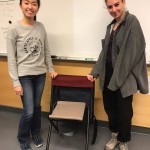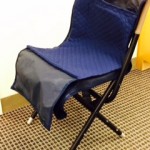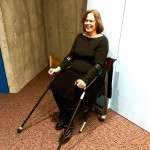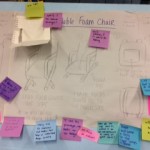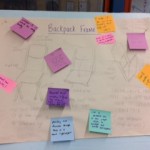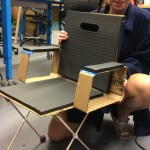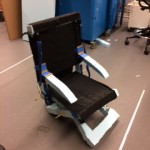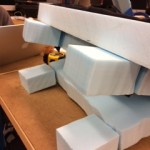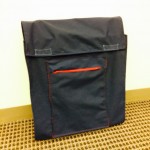Final Documentation: SuperChair
Authors: Calla Nelles-sager & Angela Wang
ABSTRACT SUMMARY:
There are many portable chairs on the market but most are designed for camping or the beach. Our aim was to create a light, comfortable chair that was aesthetically pleasing enough to carry around in everyday life while walking or going to sporting events. This chair would provide a convenient way to rest at all times, especially for people with limited mobility and strength.
This chair consists of a pre-manufactured light, sturdy metal frame and cotton fabric seat. From there, we added telescoping legs which extend for a maximum 20” of seat height. There is also a padded, water resistant chair cape which can be folded over to provide extra cushioning while sitting. In addition, if the chair cape hangs over the back of the chair, and is velcroed to the side straps, the chair cape pocket can be accessed while sitting. This chair pocket can hold everyday necessities such as a phone, wallet, keys and even a water bottle. To fold the chair up, the chair cape wraps around the chair and fastens with two velcro side straps. Lastly, the airplane-style strap for wearing the chair only requires one hand to release the buckle. Because of the unique chair cape element, we decided to call this chair, the SuperChair.
PROCESS OF CHAIR CREATION:
Our first stage of chair creation was brainstorming ideas. After researching current portable chairs for inspiration, we created three main chair designs: the Beach Chair, Foam Chair and Backpack Frame. Our beach chair design utilized two large rectangular frames with a fabric back and seat. For storage, a fabric pocket could hang from one of the rectangular legs, then to fold in, the rectangular leg without the pocket would fold in first, then the pocket would be accessible from the outside while carrying the chair backpack. Another plus to this design was the seamless integration of armrests within the chair legs.
Soon after, we realized that this chair design had already been created by Bed Bath and Beyond, so we decided to go with another design. Our next design used this foam chair from Rakuten as the base of our foam chair design. From there, our legs would fold under the seat. Then, the frame would fold down with the armrests, so this chair would simply integrate armrests. Once folded up, there would be a pocket attached to the back of the foam chair Our main concern for this chair design was the comfort of having the legs against your back when carrying. And if the legs were on the other side of the backpack, aesthetics would be an issue.
Lastly, our backpack frame design was the most similar to our end design because our frame folds down, the legs fold up, then the chair cape folds all the way around the chair to look like an actual backpack. In addition, this design has no armrests, which is similar to our final model.
Then we incorporated our three designs into a life sized sketch model. Our sketch model used cardboard as a basis with yoga mat foam for the outer covering of the chair seat and chair back. For the legs, we used criss cross wooden poles attached with string and hot glue and purple play dough for the base of the leg to stick to the ground more. For the back of the chair, we glued a breathable mesh material for a comfortable material against the back. Lastly, we created our backpack straps with yoga mat backpack straps and our 3-D printed buckles, and our chair cape from cloth and attached it with velcro strips. This sketch model combined the foldable armrests and legs of the foam chair design along with the chair cape of the backpack frame design.
Our sketch model captured our ideas but did not stand so it was not a functional chair. Our next step therefore was to create a functional prototype. We decided that the most important issue to address with this prototype was to create a functional leg design at the desired height of 19-20 inches. Since we needed a material that was sturdy enough to stand on its own, we decided to build this prototype out of foam. We cut the legs, back frame and armrests out of foam then stuck pencils into the foam to make hinges. To attach the armrests to the back frame, we used cardboard as hinges. Then, we used the same black animal print for the fabric of the chair and back as well as the chair cape, and attached the chair cape with velcro. Since our airplane release straps had not come yet, we used the same backpack straps as our first prototype. Lastly, we realized that the chair must be higher, so we added removable chair extensions with mini square foam pieces attached by bamboo skewers.
This prototype differed in many ways from our sketch model since we had to now make it realistic. Instead of the foam chair top which was too heavy for functional legs, we adopted the backpack frame design that was lighter. This meant that our armrests attached to the chair frame instead of being as seamless as before with the foam chair. These armrests extended down and folded up, and while on your back, they stuck out on either side of your waist which was not aesthetically pleasing. We would later scrap the idea of armrests and just focus on the legs. Another necessary change we made was the way our legs folded. Instead of folding under the seat like before, we had the legs fold up with the seat. This is the method of leg folding that we ended up with.
To start our final project, we again researched previous portable chairs on the market. While researching portable chairs that are currently on the market, we could not find any compact chairs with a seat height above 16 inches. This short seat height would make it difficult for people to get in and out of. To solve this problem, we could either add armrests that people could push up from to get out of the chair easier, or extend the length of the chair legs. First, we bought a camping chair with foldable legs. Since this chair did not come with armrests, we prototyped different types of armrests, including arms that attached to the back with a chain, arms that had a block underneath, and U-shaped arms that went around the chair. None of these prototypes allowed for the user to push on them without collapsing the chair and some made the chair unmanageably large and bulky. Simultaneously, we built telescoping legs that extended to a seat height of 20 inches. We decided on this height because it was easy to get up from, for all users, so it negated the need to have armrests.
Our telescoping legs have two settings, one with an inch of extension, and the other setting for five inches of extensions. These legs are not the most user-friendly because they require the user to extend each of the legs, one at a time. But, to keep our chair compact, we decided this was the best solution. Right now, our legs telescope using push buttons but, ideally, they would telescope using a method that requires less dexterity. Possible future options could be adding springs to our telescoping legs to twist them out, however this would still require four steps.We had hoped to find rectangular shaped legs that could telescope which would only require two steps instead of four to telescope and fold. Overall, the biggest issue of this project was creating sturdy yet light and compact legs.
From there, we concentrated on the aesthetics and comfort of the chair. We created a chair cape which attaches to the back of the chair. This water-resistant chair cape would have a pocket that could be accessed while sitting. This stylish navy pocket with a maroon colored zipper could store a phone, keys, wallet and water bottle. Also while sitting, the chair cape could be folded over to provide padding on the chair back and seat.
After the chair folds up, the cape wraps around the chair to attach via two velcro side straps. This would allow the chair to fold up with the telescoping legs at any height. Previously, we had extended the chair cape to have a flap that would fold over the legs and velcro to the other end of the chair cape. However, this would mean that the user would have to manually shorten the telescoping legs each time. Instead, we made it easier so that the user would not need to shorten the legs, but instead could use side straps to wrap the chair up.
|
BEFORE: |
AFTER: |
Lastly, when the chair is folded up, it is easily wearable because it uses one crossbody airplane release strap. This strap only requires one hand to release the buckle, making it accessible for people with limited hand strength or mobility.
REFLECTION:
Now that we have finished our project, we tested our final product against our initial requirements. The time it takes us to assemble the chair was ideal, as it takes us less than 20 seconds to set chair up, less than 30 seconds to close the chair up, and less than 1 minute if we telescope the legs as well. Altogether, the chair weighs less than 5 lbs, so it is highly portable. The pocket is able to fit everyday necessities, like a pair of keys, phone, wallet and a water bottle, and could also be used to store larger things like a small laptop. Altogether, it can store over 300 cubic inches. Next, the chair fits to the body very well with the adjustable strap and universal chair height. The change time from standing or sitting is less than 5 seconds which is ideal.
INDEX: INSTRUCTIONS
Folding the Chair into Backpack:
- Fold the seat first
- Fold the back frame over the seat
- Wrap the chair cape around
- Fasten the ends with velcro
- Clip buckle, then put on strap
- Adjust strap if needed
** Telescoping legs back to short position is optional**
Unfolding Backpack into Chair:
- Release airplane strap
- Unpeel velcro straps on either side of chair
- Open the back frame first
- Open the seat
- Now here you have two options
- Chair Cushion: Flip the chair cape over the seat to provide a seat cushion
- Chair Pocket: Let the chair cape hang from the back and fold the cape up with velcro, so you can access the chair pocket
